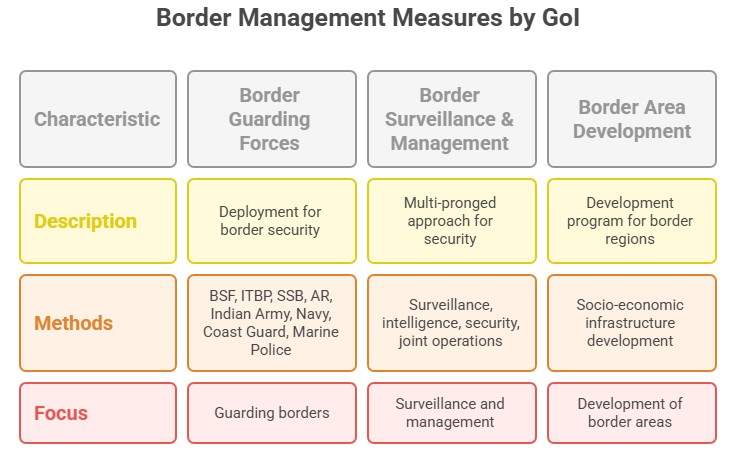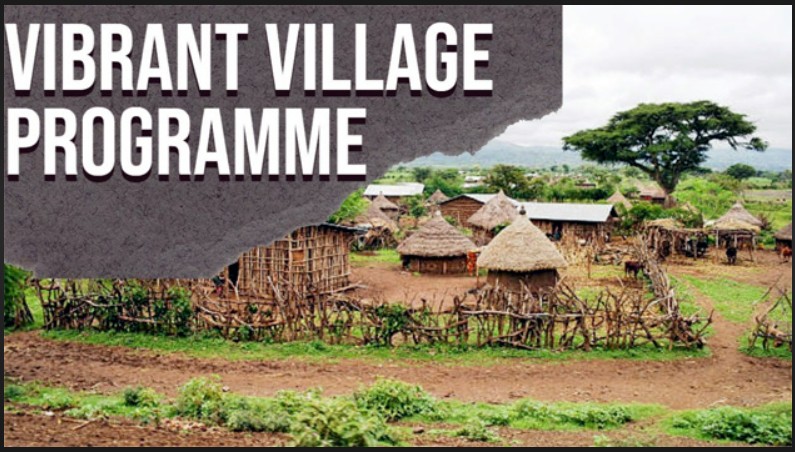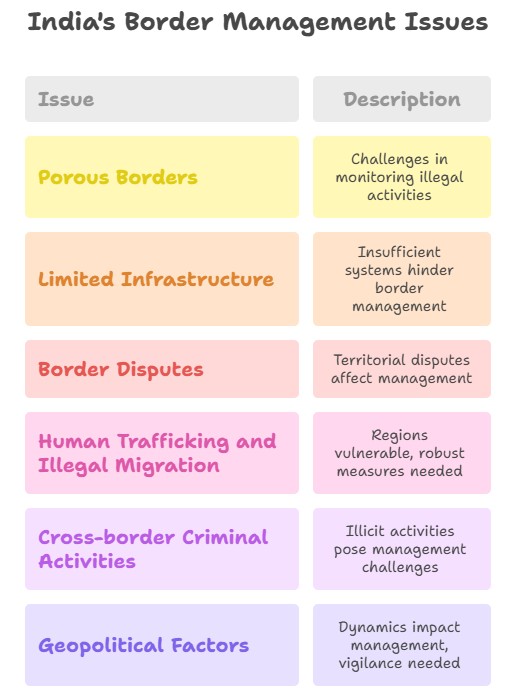“Our flag does not fly because the wind moves it, it flies with the last breath of each soldier who died protecting it.”
According to the UNSC, border management is the first line of defense against the movement of terrorists across borders and the illegal cross-border movement of goods and cargo.
Border management is an integral part of India’s defense and commerce. India’s border management comprises border security, border region development, communication, and coordination with the neighbouring states and programs to enhance the national interests of India.

Aim of India’s Border Management
- To secure Indian border against hostile neighbour
- To facilitate legitimate trade
- To increases cross border cooperation
- Maintaining peace and coexistence
Role of MHA in India’s Border Management
- Management of international lands and coastal borders
- Strengthening of border guarding
- Creation of infrastructure such as roads, fencing, and lighting of borders.
- Approach and practices of border management vary from one border to another, based on the security perceptions and relationship with the neighbouring country.
India’s Border Management Measures by Government of India
- Deployment of border guarding forces - Guarding of the Indian borders is undertaken by the various border guarding forces, which are deployed along different borders as below:
- Border Security Force (BSF): The security of Bangladesh and Pakistan border
- Indo-Tibetan Border Police (ITBP): The security of the China border
- Sashastra Seema Bal (SSB): Nepal and Bhutan border.
- Assam Rifles (AR): Indo-Myanmar Border.
- LoC on the Indo-Pakistan border and the LoAC on the Indo-China border is protected by the Indian Army (along with BSF & ITBP forces, respectively)
- Indian Navy is responsible for overall maritime security, which includes coastal & offshore security.
- Indian Coast Guard (ICG) – additionally designated for coastal security in India’s territorial waters including areas to be patrolled by the Coastal Police.
- The coastal State (Marine) Police acting as the second line for coastal patrol.
- Border Surveillance and Management ???? Multi-pronged approach
- Surveillance
- Round-the-clock surveillance and regular patrolling on the borders and establishment of observation post.
- Use of Electronic surveillance equipment such as night vision devices, handheld thermal imagers, surveillance radars, direction finders, unattended ground sensors and high-powered telescopes.
- Intelligence gathering & Sharing - upgradation of intelligence setup and enhanced coordination with the state governments and concerned intelligence agencies.
- Border security
- Construction of border fencing and floodlighting.
- Technological solutions, such as Comprehensive Integrated Border Management System (CIBMS), for vulnerable areas where physical fencing is not feasible (along Indo-Pakistan border and Indo-Bangladesh border).
- Use of watercrafts/boats and floating Border Out Posts (BOPs) for domination of riverine area of the border.
- Conduct of joint operations with neighbouring countries.
- Development of border areas
- Lack of economic opportunities makes the border population more susceptible to illegal activities such as drugs and smuggling.
- Difficult terrain and lack of proper roads and infrastructure keep the border areas inaccessible and underdeveloped.
- As a solution to tackle these issues, the government initiated the ‘Border Area Development Program’ (BADP) in 1987, to facilitate the provision of the required socio-economic infrastructure and adequate security, and to eliminate a sense of alienation among the population living at the border.
- Projects include construction of roads, bridges, education, skill development, safe drinking water, health, agriculture, sports activities, promotion of rural/border tourism etc.

Security Challenges to India along Borders

Key Issues Affecting India’s Border Management
- Porous Borders: Challenges in monitoring and controlling illegal activities due to porous border areas.
- Limited Infrastructure: Insufficient roads, fencing, and surveillance systems hindering effective border management.
- Border Disputes: Ongoing territorial disputes with neighbouring countries affecting border management efforts.
- Human Trafficking and Illegal Migration: Border regions vulnerable to human trafficking and illegal migration, necessitating robust border management measures.
- Cross-border Criminal Activities: Illicit activities like organized crime, drug trafficking, and arms smuggling posing challenges to border management.
- Geopolitical Factors: Geopolitical dynamics and regional conflicts impacting border management, requiring adaptability and vigilance.
Role of Technology in Strengthening India’s Border Management
Introduction
- Recently government has approved report of Task Force created by Ministry of Home Affairs to identify areas for use of Space Technology in improving Border Management.
- Madhukar Gupta committee recommended the use of scientific technology in border management. For example, use of laser fencing, ground sensors and thermal imaging where physical fencing is not feasible due to difficult terrain.
Significance
- Enhanced Surveillance: Technology enables real-time monitoring and detection of potential threats at the border.
- Improved Situational Awareness: Advanced technologies provide accurate and up-to-date information for informed decision-making.
- Efficient Screening and Authentication
- Biometrics and facial recognition streamline identification processes and detect fraudulent documents.
- Data Integration and Analysis: Technology integrates data sources to identify suspicious patterns and potential risks.
- Communication and Coordination: Seamless communication and coordination among agencies enhance information sharing and rapid response.
- Border Infrastructure Development: Technology aids in the construction of infrastructure for efficient and secure movement of goods and people.
Challenges
- Cost and Budget Constraints: Limited financial resources may hinder the implementation and maintenance of advanced technologies.
- Technical Complexity: Integrating different technologies requires specialized knowledge and expertise.
- Vulnerabilities and Cybersecurity Risks: Technology systems are prone to hacking and cyber-attacks, necessitating robust security measures.
- Environmental Factors: Harsh conditions and remote locations can impact technology performance and infrastructure requirements.
- Training and Capacity Building: Adequate training is crucial to ensure personnel are skilled in utilizing technology effectively.
- Privacy and Data Protection: Balancing technology use with privacy rights and data protection regulations presents challenges.
Steps for Effective India’s Border Management
- Adopt a risk-based approach: Focus resources on high-risk areas and individuals while facilitating low-risk trade and travel.
- Invest in technology and infrastructure: Enhance border control capabilities with biometric systems, automated screening, and surveillance equipment.
- Foster interagency cooperation: Share information and collaborate among border control, law enforcement, customs, and immigration agencies.
- Strengthen international cooperation: Work with neighbouring countries and international partners to address cross-border threats.
- Develop robust risk assessment and intelligence capabilities: Identify and target high-risk individuals, goods, and activities at the border.
- Provide specialized training: Equip border control personnel with the necessary skills and knowledge.
- Streamline procedures: Simplify and harmonize border processes while maintaining security measures.
- Promote public awareness: Educate the public about border regulations and encourage reporting of suspicious activities.
- Communicate traveller information: Provide accurate and timely information to travellers regarding border requirements and risks.
Steps taken by Government for Effective Border Management for Land Borders
Legal Support for India’s Border Management
Armed Forces (Special Powers) Act, 1958
Context
Recently the Centre has further reduced the number of areas in Assam, Nagaland and Manipur that were declared disturbed areas under the AFSPA due to an improvement in the security situation.
About the act
- Armed Forces (Special Powers) Act (AFSPA) is a legislation enacted in 1958 in India to grant special powers to the armed forces in designated "disturbed areas."
- AFSPA grants the armed forces the authority to maintain public order and take necessary actions, including arrest, search, and use of force, in areas declared as "disturbed" by the central or state government.
- The act provides legal immunity to armed forces personnel for their actions performed under AFSPA, unless a prior sanction for prosecution is obtained from the government.
- Several states in India, including Jammu and Kashmir, Manipur, Nagaland, Assam, and parts of Arunachal Pradesh, have been declared as "disturbed areas" under AFSPA.

Infrastructure Push: Infrastructure push along the Indo China border by BRO, E.g.-Dhola Sadiya bridge.
- Subregional connectivity project. E.g., Agartala-Akhaura Rail-Link
Technological Push: Comprehensive Management System (CIBMS) to establish an integrated security system at borders providing all round electronic surveillance even in adverse climatic conditions.
- Project BOLD-QIT (Border Electronically Dominated QRT Interception Technique) under Comprehensive Integrated Border Management System (CIBMS)
Community Participation
Vibrant Village Programme

About the Scheme
- Centrally sponsored scheme: It is a scheme introduced in the Union Budget 2022-23 (to 2025-26) aimed at the development of villages on the northern border.
- Focus areas: The scheme will cover the border areas of Himachal Pradesh, Uttarakhand, Arunachal Pradesh, Sikkim, and Ladakh.
- Village coverage: A total of 2,963 villages will be covered under the scheme, with the first phase targeting 663 villages.
- Vibrant Village Action Plans: District administrations, in collaboration with Gram Panchayats, will develop Vibrant Village Action Plans for effective implementation of the scheme.
- No overlap: The scheme will not overlap with the Border Area Development Programme, ensuring distinct focus and coverage for the identified villages.
Objective
- Economic drivers: Identify and develop economic drivers in border villages.
- Growth centers: Establish growth centers through social entrepreneurship and youth/women empowerment.
- Tourism promotion: Leverage local heritage and cultural knowledge for tourism development.
- Sustainable eco-agri businesses: Foster eco-agri businesses based on the "one village-one product" concept.
- Resource utilization: Maximize utilization of local resources for overall village development.
Significance
- Transforming border villages: The initiative aims to transform border villages near neighbouring countries, improving their living conditions.
- Essential amenities: Basic facilities such as housing, roads, water, electricity, education, healthcare, and communication will be provided to these villages.
- Retaining population: By offering better infrastructure and amenities, the initiative aims to encourage people to stay in their native border areas, reducing outmigration.
Strengthening border security: The development of border villages contributes to improved border security by maintaining a stable population presence in these strategic regions.
Army Reform Linked to India’s Border Management
Agneepath Scheme
Recent Context
- The government has recently introduced the "Agnipath" scheme, aimed at recruiting soldiers for all three branches of the armed forces, namely the Army, Navy, and Air Force.
About the Scheme
- The Agnipath Scheme, also known as Tour of Duty, aims to recruit soldiers on an "All-India All-Class" basis for short-term and long-term service in the Army, Navy, and Air Force.
- The scheme aims to divert resources for military modernization by reducing salaries and pensions.

Other recent Initiatives Along the Borders
- Border Protection Grid
- To be set up in Indian states bordering Bangladesh.
- The grid will comprise various elements, such as physical barriers, non-physical barriers, surveillance system, intelligence agencies, state police, BSF and other state and central agencies.
- Recent Implementation of Shekatkar Committee recommendations relating to border Infrastructure – for speeding up road constructions.
Way Forward
- Increased Investment: Allocate more funds for advanced technology in border management.
- Expertise Development: Provide training to enhance technical skills of personnel.
- Cybersecurity Measures: Implement strong protocols to protect against cyber threats.
- Resilient Infrastructure: Build robust infrastructure for reliable technology support.
- Public-Private Partnerships: Collaborate with tech providers for expertise and cost-sharing.
Conclusion
Effective land border management requires infrastructure development, technology utilization, cooperation with neighbouring countries, and robust law enforcement. It ensures security, facilitates lawful trade, and combats threats.


















